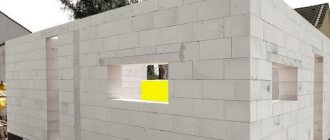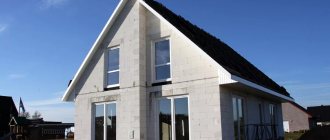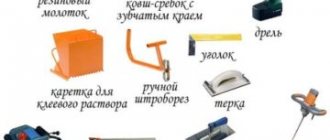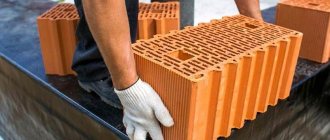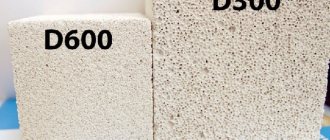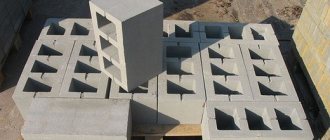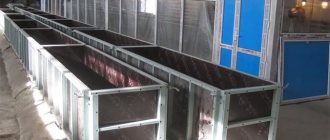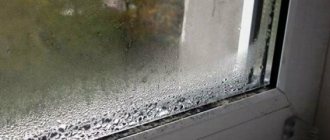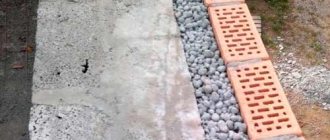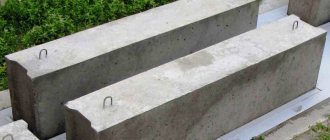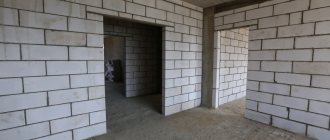Aerated concrete and gas silicate: what is the difference between them?
In conditions of constant rise in energy prices, the need for building materials with high thermal characteristics is increasing. To reduce heat loss, modern projects are increasingly using aerated concrete and gas silicate blocks - materials of the class of thermal insulating cellular concrete. They are often confused due to their common properties and the same scope of application. Even specialists cannot always immediately tell a potential customer which material is in front of him - gas silicate or aerated concrete, which is better, what is the difference between them and whether there is any at all. Partly, the confusion is caused by the manufacturers themselves when they define aerated concrete as a type of gas silicate or vice versa.
What is the difference between aerated concrete and gas silicate? In particular, when producing aerated concrete, natural hardening of the block in the open air is allowed; for gas silicate, autoclave ovens are a prerequisite. In addition, for aerated concrete blocks the main binding component is cement, while for silicate analogues it is lime. The use of different components affects the color of the finished blocks.
If we talk about specific characteristics, you can notice the following differences:
- Gas silicate blocks have a uniform distribution of hollow cells, which ensures high strength.
- The weight of aerated concrete blocks is much greater, which requires a reinforced foundation during construction.
- In terms of thermal insulation, gas silicate blocks outperform aerated concrete blocks.
- Aerated concrete absorbs moisture better, which provides a greater number of freezing cycles.
- Gas silicate blocks have a more consistent geometry, which makes the finishing of wall structures easier.
Externally, finished products are distinguished by color: gas silicate or autoclaved aerated concrete is almost white, gray color is typical for non-autoclaved aerated concrete.
The average values for each parameter are shown in the following table:
In terms of durability, the materials are identical and can last more than 50 years.
If you answer the question: “What is better, aerated concrete or gas silicate?”, gas silicate blocks have much more technical advantages. However, manufacturing technology forces an increase in the cost of finished products, so aerated concrete blocks are cheaper. Therefore, those who want to build a house from high-quality and modern material choose aerated silicate; those who want to save on construction - give preference to aerated concrete.
In this case, it is necessary to take into account the region of application: in areas with high air humidity, the service life of gas silicate blocks is noticeably reduced.
Specifications
It makes sense to look at the main technical characteristics of gas silicate material:
- The value of the specific thermal capacity of block material made using the autoclave method is 1 kJ/kg*°C. For comparison, the same figure for reinforced concrete stone reaches only 0.84.
- The density of reinforced concrete material is five times higher, but the thermal conductivity of the gas silicate block is only 0.14 W, and this figure can be compared with coniferous wood. For reinforced concrete, this coefficient is 2.04.
- The noise absorption of gas silicate is 0.2 if the sound frequency is 1,000 Hz.
- The frost resistance of blocks, the average density of which does not exceed 400 kg, is not standardized; for material with an indicator of 600 kg it reaches three and a half dozen freeze-thaw cycles. Denser stones can withstand up to fifty cycles. It turns out that the maximum service life of such gas silicate blocks is 50 years.
If we make a comparison between blocks and brick material, then the indicators will not be in favor of the second material. To obtain a sufficient level of thermal conductivity, a gas silicate wall must be at least fifty centimeters wide. And for brickwork this value is 2 meters. In addition, when masonry is made from blocks, the consumption of mortar mass is reduced significantly.
The weight of one square meter of masonry made of gas silicate material will not exceed two hundred and fifty kilograms, while a brick section will weigh about two tons. Here it should be taken into account that the thickness of the foundation will vary, which will also affect the expenditure of funding allocated for construction work. The compressive strength of both materials is so different that for gas silicate masonry a half-meter wide foundation will be enough, while for brick you will need a foundation a couple of meters wide.
Installation of block masonry is easy, which will reduce labor costs.
In addition to all that has been said, blocks are considered an environmentally friendly material. The coefficient for this item is such that gas silicate can be compared with natural wood. But for brick this value is 8 – 10 units.
Composition and production technology of gas silicate blocks
The mixture for the production of gas silicate blocks has the following composition:
- binder (Portland cement according to GOST 10178-76, calcium lime (according to GOST 9179-77);
- silicate or siliceous filler (quartz sand with 85% quartz content, fly ash, etc.);
- lime, with a content of magnesium and calcium oxides of more than 70%, and a slaking speed of up to 15 minutes;
- technical water;
- gas-forming additive (aluminum powder and others).
Gas silicate belongs to the class of lightweight cellular concrete. This material is a mixture consisting of 3 main components: cement, water and fillers. Lime and quartz sand in a ratio of 0.62:0.24 can act as fillers. We should also talk about the additives that give gas silicate its individual characteristics. Fine aluminum powder acts as an additive. All these components are thoroughly mixed, and under certain conditions, foaming of all these materials occurs. When aluminum powder reacts with lime, hydrogen is released. The huge number of hydrogen bubbles released makes up the porous structure, which is the main distinguishing feature of gas silicate. Its structure resembles a concrete “sponge”, since the entire volume of the block consists of cells (bubbles with a diameter of 1-3 mm).
Gas silicate blocks
The cellular structure makes up almost 85% of the volume of the entire block, so this material is very light in weight. First, a mixture of components is prepared in a special mixer for 5 minutes, which includes Portland cement, fine sand (quartz), water, lime and a gasifier (most often, this is an aluminum suspension). Hydrogen produced by the reaction between aluminum paste (powder) and lime forms pores. Bubbles ranging in size from 0.6 to 3 mm are evenly distributed throughout the material.
Basic chemical reactions take place in metal containers or molds. The mixture is subjected to vibration, which promotes swelling and setting. After hardening, all surface irregularities are removed with a steel string. The formation is divided into blocks, and then they are sent to an autoclave unit. The final calibration of the finished blocks is carried out by a milling machine.
Gas silicate blocks are manufactured only using the autoclave method. Aerated concrete blocks can be produced both by autoclave and non-autoclave methods (natural hardening of the mixture):
- Autoclave processing. This stage significantly improves the technical characteristics of gas silicate. Here, steam treatment is carried out for 12 hours at high pressure, the temperature of which is almost 200°C. This heating process makes the texture more uniform, thereby improving the strength properties (at least 28 kgf/m²). Its thermal conductivity is 0.09-0.18 W (m∙K), which makes it possible to erect walls in one row (400 cm) in almost any climatic conditions, but excluding the northern regions.
- Non-autoclave technology. It consists in the natural hardening of the mixture: moistening and drying under natural conditions. In this case, it is quite possible to do it yourself, since no special equipment is required. The strength of blocks in such production does not exceed 12 kgf/m².
The first type is more expensive. This is due to significant manufacturing costs, as well as the best technical characteristics of gas silicate blocks produced by this method. They are much stronger, their thermal conductivity coefficient is lower. The pores inside such gas silicate are distributed extremely evenly, which affects the precise compliance of the material with the specified parameters.
Advantages and disadvantages
The advantages of gas silicate material include the following positive qualities:
- Light weight - no need to use loading and unloading equipment. Having a masonry tool, you can carry out construction work yourself;
- numerous void spaces guarantee excellent insulation from extraneous noise;
- blocks are easily processed with manual materials - a hacksaw, grater, etc.;
- low level of thermal conductivity - the house will be warm, a comfortable microclimate will always be maintained indoors;
- construction work is completed quickly because the blocks are large in size. If there is a special grip, the block is convenient to move and stack;
- the material belongs to the group of low-flammable materials.
Objects made from such material are comfortable and environmentally safe. The excellent vapor permeability of the blocks allows the walls to “breathe”. But a house made of such material is built on two floors, and if the gables are high, then on one. Otherwise, the lower rows of masonry may collapse from the heavy weight.
In addition to positive qualities, there are also negative aspects. The block is considered a non-combustible material, but can be destroyed when exposed to high temperatures. A severe fire will make an object made of gas silicate material unsuitable for further use.
Another problematic issue is moisture absorption. Water that gets onto an aerated concrete surface almost immediately ends up inside the stone. During severe frosts, “wet” blocks may crack. To protect the material from excess moisture, water repellents are used.
Gas silicate blocks: characteristics
Density of gas silicate blocks
The brand and density of gas silicate blocks is indicated in the marking and determines the purpose of the block:
- structural gas silicate blocks – D1000-1200, have a density from 1000 to 1200 kg/m3;
- structural and thermal insulation blocks – D500-900, have a density of 500-900 kg/m3;
- thermal insulation D300-D500, the density of their materials is 300-500 kg/m3.
Blocks of different densities are easy to distinguish from each other visually.
There are several classifications of gas silicate blocks with certain technical characteristics. Today, the following grades of this material are used in construction work. The best option for low-rise construction is the d500 gas silicate block and the d600 gas silicate block.
The digital designation of the brands listed earlier shows the density of the material. In particular, the d500 gas silicate block has a density of 500 kg/m³.
Gas silicate block d600
Gas silicate block d600 is used in the construction of load-bearing walls of a house. It is also recommended for use in the construction of ventilated facades, which are well attached to blocks of such density. The d600 gas silicate block has a strength of 2.5-4.5 MPa and has a thermal conductivity of 0.14-0.15 W/(m°C)
Gas silicate block d500
Gas silicate block d500 is most popular for low-rise (up to 3 floors) construction. This variety is also used in monolithic construction. Its parameters are 2-3 MPa (strength) and 0.12-0.13 W/(m°C) (thermal conductivity).
When building a house higher than three floors, you should give preference to gas silicate with a marking higher than D600 and additionally insulate the walls. Based on the value of the thermal conductivity coefficient, we can conclude that the d500 gas silicate block is 15-17% warmer than the d600 gas silicate block.
Gas silicate block d400
This type is used for arranging insulation and for working with openings during the construction of multi-storey buildings using the monolithic method. The D400 brand is also popular in private construction. With high strength, it has great heat-insulating properties. These indicators are in the range of 1 MPa to 1.5 MPa (strength), 0.10-0.11 W/(m°C) (thermal conductivity).
Gas silicate block d300
Brand D350 can only be used as insulation. This is a rather rare brand on the domestic market, due to its fragility. Strength is in the range of 0.7-1.0 MPa. But it differs in thermal conductivity, which is 0.08-0.09 W/(m°C).
Thermal conductivity of gas silicate blocks
Depending on the proportions of the starting ingredients, you can obtain a product with different performance characteristics. The thermal conductivity coefficient of a gas silicate block depends on its density and is determined by the marking: D300, D400, D500, D600, D700.
The thermal conductivity of gas silicate depends on a number of factors:
- Dimensions of the building block. The greater the thickness of the wall block, the higher its thermal insulation properties.
- Ambient humidity. Material that has absorbed moisture reduces its ability to store heat.
- Structure and number of pores. Blocks that have a large number of large air cells in their structure have increased thermal insulation properties.
- Density of concrete partitions. Higher density building materials retain heat less well.
Thermal conductivity table for gas silicate blocks
Photos of houses
Aerated concrete blocks retain heat well in the cottage, but only as long as they remain dry. If gas silicate walls on the facade are not reliably protected from precipitation, then they will not last long. In terms of cost, this building material outperforms many analogues. However, in the general estimate for the construction of such a building, it is necessary to take into account the obligation to complete its façade finishing.
For houses that are planned to be built from gas silicate blocks, there is no need to make an expensive and powerful foundation. This building material does not weigh that much. However, the foundation for masonry from it must have a grillage or be strip. The slightest distortion will inevitably lead to the appearance of cracks in the enclosing structures of their aerated concrete.
Gas silicate is inferior to brick in strength, but benefits in terms of thermal efficiency and less load on the foundation. The foam concrete analogue, with equal density, will also win in the matter of heat preservation. However, aerated concrete is much inferior to both of them in terms of moisture absorption. You need to choose this material thoughtfully, having first weighed all the pros and cons. It will take more money to finish and waterproof a home than for a brick or wooden building.
View of a block house
Unusual house geometry
House "under the roof" made of blocks
This is what walls made of high-quality gas silicate with the correct geometry look like
Plastered walls of gas silicate blocks
It is better not to leave the blocks open during the winter.
Construction of walls from gas silicate blocks
From such blocks you can make an unusual geometry of the house
House with a turret
Partition gas silicate blocks were used above the window spaces
Openings and niches can be easily cut with a hacksaw
In this example, the house is made with narrow windows
You can also try making semicircular walls
Gas silicate house with wooden floors
Most often, such walls are faced with brick.
Types of gas silicate blocks
Based on appearance, there are several configurations of the gas silicate block. The classification is based on the purpose of the block.
- Smooth (straight) gas silicate block with hand grip
An absolutely smooth rectangular gas silicate block with recesses for gripping by hand. The gripper is easy to use because it allows you to easily move the blocks. The presence of grip handles increases glue consumption, since the technology of laying gas silicate blocks involves filling all voids during the work process.
- Wall gas silicate blocks with flat edges
The usual rectangular shape reduces glue consumption, but creates difficulties in moving the block. In practice, when constructing load-bearing walls where larger blocks are used, preference is given to a block with a grip.
- Gas silicate blocks for partitions
They are blocks with flat edges. Partition blocks are thinner and lighter in weight. It's convenient to work with them.
You can cut out any designs on straight blocks using a screwdriver. But such decor is more likely to be used in finishing a site with the remains of blocks from construction rather than in the construction itself, since it is advisable to protect gas silicate with external finishing material.
- Tongue-and-groove gas silicate wall blocks
The formation of a tongue-and-groove connection system, in terms of production complexity, is classified as a high-tech block processing. Therefore, they are more expensive. However, it is justified because: it increases the speed of work, reduces glue consumption (vertical joints do not require gluing), and it becomes possible to eliminate cold bridges in places of vertical joints.
If the house will not undergo external finishing. It is better to apply a thin layer of glue to the joint from the front side of the masonry. This will provide additional insulation to the seam.
- U-shaped gas silicate blocks
The purpose of U-shaped blocks is to install hidden construction elements (for lintels and monolithic belts). According to the technology, masonry of walls made of gas silicate blocks requires mandatory reinforcement of the first and every fourth of the subsequent rows. It is precisely in order to conveniently hide the reinforcement that the voids in the U-shaped blocks are intended. After laying the reinforcing metal, the space must be filled with concrete mortar or glue. In this case, cheaper filling material should be used.
Dimensions and shape
A block is considered to be a product with a rectangular cross-section and a thickness slightly less than its width. In shape, a gas silicate block can resemble a regular parallelepiped with smooth surfaces or with grooves and protrusions at the ends (locking elements) - the so-called tongue-and-groove blocks; May have grab pockets. It is also possible to produce U-shaped blocks. Blocks are available in a variety of sizes, but the following limits should not be exceeded:
- Length - 625 mm;
- Width - 500 mm;
- Height - 500 mm.
According to the permissible deviations from the design dimensions, wall blocks belong to categories I or II, within which a certain difference in the lengths of the diagonals or the number of rib breaks are not considered rejection defects (for more details, see GOST 31360-2007).
What are the sizes of gas silicate blocks?
Of course, manufacturers produce gas silicate blocks of different sizes. However, most enterprises try to follow the established standards of GOST No. 31360 of 2007. Here are the dimensions of the finished products:
- 250*250*600.
- 250*400*600.
- 500*200*300.
- 600*100*300.
- 600*200*300.
It is important to understand that according to GOST, deviations in length and diagonal values are allowed, which classify finished products into the 1st or 2nd category.
Deviations in the dimensions of gas silicate blocks reduce installation time due to the absence of the need for grinding and adjustment.
- Thickness of gas silicate blocks: 200, 250, 300, 350, 375, 400, 500 mm;
- The thickness of the partition blocks is 100-150 mm;
- Length of gas silicate blocks: 600, 625 mm;
- Height of gas silicate blocks: 200, 250, 300 mm;
- Weight of gas silicate blocks: 14-34 kg;
- In 1 cubic meter from 13 to 33 pcs. (depending on thickness);
- Consumption per 1 sq.m. walls is 6.7-7 pcs.
The exact parameters are shown in the tables below:
Dimensions of a U-shaped gas block The size of a gas silicate block for walls (LxWxH) from different manufacturers and the number of pieces on a pallet.
Number of blocks in a pallet
Weight of gas silicate block
The structural mass of the block varies depending on the density of the finished product. Judging by the markings, we can distinguish the following weight:
- D400. Weight 5-21 kg.
- D500/D600. Weight – 9-30 kg.
- D700. Weight – 10-40 kg.
In addition to density, the fundamental factor in weight change is the overall size of the finished block.
Kinds
Gas silicate blocks are divided into three main types depending on the degree of strength:
- Structural. This material is used for the construction of buildings not exceeding three floors. The block density is D700.
- Structural and thermal insulation. This type of gas silicate is used for laying load-bearing walls in buildings no higher than two floors, as well as for the construction of interior partitions. Its density ranges from D500 to D700.
- Thermal insulation. The material is successfully used to reduce the degree of thermal transfer of walls. Its strength is low, and due to its high porosity the density reaches only D400.
Gas silicate building blocks are produced in two ways:
- Autoclaved. The manufacturing technique involves processing the material under high steam pressure of 9 bar and a temperature of 175 degrees. This steaming of blocks is carried out in special industrial autoclaves.
- Non-autoclave. The prepared gas silicate mixture hardens naturally for more than two weeks. At the same time, the required air temperature is maintained.
Production of gas silicate blocks
Gas silicate produced using autoclave processing has the highest technical characteristics. Such blocks have good strength and shrinkage characteristics.
